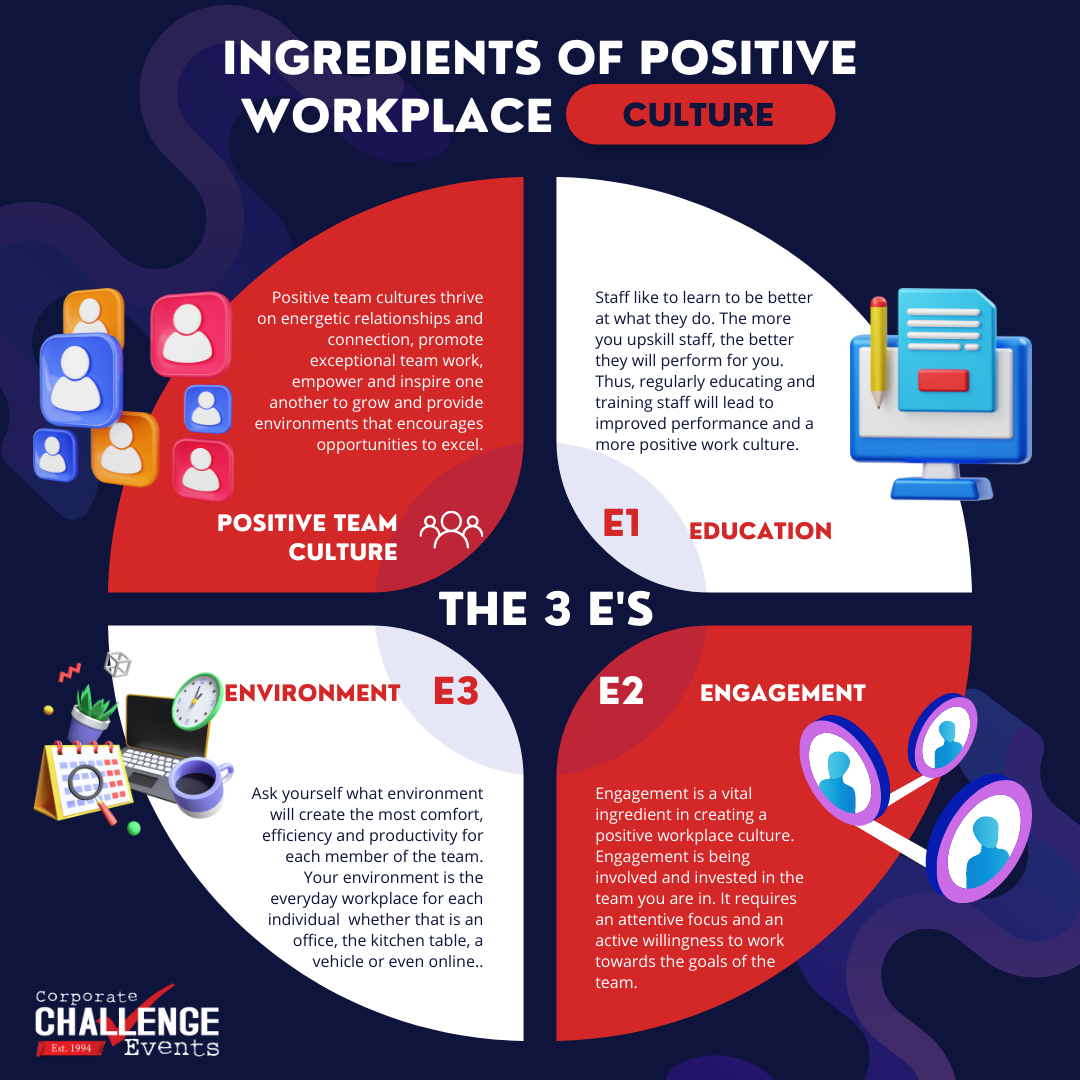Building an effective team is much like crafting a masterpiece – it requires skill, patience, and above all, a clear vision. Over the past 29 years, we’ve experienced this firsthand. Through the highs and lows, through a global financial crisis and a worldwide pandemic, our team has been our rock, our constant.
But it wasn’t always smooth sailing. There were times when we felt more like a group of individuals than a cohesive unit. Times when morale was low, and tensions were high. But each challenge served as a stepping stone, pushing us to focus not just on our business, but on the people who make it what it is. The story behind our own team journey can be found here: Read Now.
In our previous posts, we’ve taken a close look at optimising team building frequency and unravelled the science that makes a team effective. But as we explored these topics, we found ourselves repeatedly coming back to three fundamental elements – Education, Engagement, and Environment. These three E’s, which you might recall from our earlier articles, form the cornerstone of effective team dynamics and conducive to a positive team culture.
But theory is just one part of the equation. It’s time we delve into the practical side of things – how do we put these theories into practice? How do we transform ideas into actions that yield tangible results?
In this blog post, we’ll guide you through this process, providing actionable strategies you can apply right away. We’ll also delve into the role of leadership in nurturing these three E’s and the importance of a holistic approach to enriching team cultures.
So, grab a cup of coffee, settle in, and let’s get started. Because better teams don’t just happen – they’re built with intention, effort, and a whole lot of teamwork.

Putting the 3 E's Together for Positive Team Cultures
Before we deep dive into actionable strategies, let’s revisit the theory that has underpinned our approach to team building and building positive team cultures. Throughout our 29-year journey, we’ve discovered that creating a thriving team culture isn’t about quick fixes or one-off initiatives. It’s about consistently nurturing three fundamental elements that we’ve come to call the 3 E’s: Education, Engagement, and Environment.
Education is the first of these elements. This isn’t just about formal training – it’s about ongoing development and well-being. It’s about fostering an atmosphere of continuous learning, where team members are encouraged to grow personally and professionally.
The second E, Environment, is about creating the right conditions for this growth to take place. It’s about cultivating a positive, supportive space that encourages creativity, productivity, and a sense of belonging, regardless of whether it’s a physical office or a virtual workspace.
When you combine a focus on education and a supportive environment, you naturally foster the third E – Engagement. Engagement is what happens when team members feel valued, connected, and committed. It’s the magic ingredient that transforms a group of individuals into a cohesive, thriving team.
This 3 E’s framework isn’t just theoretical for us; it’s a formula we’ve applied directly within our own team and countless others over the last 29 years.

Education
The role of education in the workplace is a key driver of organisational success. It goes beyond mere skills acquisition; it fosters a culture of continuous growth and innovation, leading to higher job satisfaction and retention rates. As we prepare for 2024 and beyond, learning and development will continue to evolve, utilising technology, personalised learning paths, and fostering a culture of lifelong learning.
A crucial aspect of this educational journey is the development of human or people skills. Human skills — sometimes referred to as “people skills” — include a number of competencies that establish an effective relationship between you and your team members.
Think of human skills as a combination of those traditional soft skills (like communication and teamwork) plus more specialised areas such as emotional intelligence, empathy and problem solving. Whereas most hard skills — like being able to program a computer or calculate complex equations — are technically measurable, human skills require a little more finesse and intuition. So in order to build better teams with higher potential, leaders need to focus on cultivating the human skills that their teams need to thrive.
Team building workshops have become an increasingly popular tool for cultivating deep human skills in teams, such as collaboration and problem solving. Research has found that these group-oriented activities can help teams break down interpersonal barriers and create stronger connections with members.
In an era where technology continues to redefine traditional work boundaries, these human skills become even more critical. They are the glue that holds a team together, enabling them to navigate through challenges and changes effectively.
To embrace this evolution of learning and development, leaders need to stay ahead of the curve. This involves adopting new technologies, promoting a culture of curiosity and continuous learning, and integrating well-being initiatives into the learning strategy. Gamifying learning and offering micro-learning opportunities can also enhance engagement and accommodate the modern employee’s busy schedule.
Ultimately, cultivating a transformative learning environment prepares employees not only for today’s challenges but also for the future. In our ever-changing business landscape, the ability to learn, adapt, and connect on a human level is indeed a competitive advantage.

Environment
The environment within which a team operates can significantly influence its effectiveness. This environment is not only physical but also psychological, and both aspects play crucial roles in team dynamics.
The physical environment encompasses the actual workspace where team members interact. It should be conducive to collaboration, creativity, and productivity. In a well-designed workspace, team members have access to the resources they need, spaces that encourage collaboration, and areas for quiet focus. As remote work becomes more prevalent, creating an effective virtual workspace is equally important. This involves leveraging technology to facilitate seamless communication and collaboration, regardless of geographical location.
However, an optimal physical environment alone is not enough. Psychological safety is equally critical. This refers to a team member’s sense of being able to take risks, voice their opinions, and make mistakes without fear of retribution or ridicule. A psychologically safe environment fosters open communication, mutual respect, and trust among team members.
Leaders play a pivotal role in shaping both the physical and psychological environment. They set the tone for how team members interact with each other and their workspace. By promoting open communication, leaders can foster a culture of transparency and trust. They can encourage team members to share their ideas and concerns, thereby promoting innovation and problem-solving.
In terms of the physical environment, leaders can advocate for resources to create a workspace that meets the team’s needs. With the rise of remote work, this includes ensuring team members have access to the necessary technology and support to work effectively from home.
Creating an environment that supports both the physical and psychological needs of team members is a complex task that requires conscious effort and ongoing attention. However, when done right, it can significantly enhance team effectiveness, job satisfaction, and overall organisational success.

Engagement
Engagement is the magic ingredient that transforms a group of individuals into a high-performing team. It’s about more than just being happy at work—it’s about feeling valued, being connected to your colleagues, and having a deep commitment to your role and the organisation.
Leaders play a pivotal role in fostering engagement. They’re not just managing tasks; they’re setting the tone for the entire team. A great leader knows how to inspire their team, communicate effectively, and create an environment where everyone feels comfortable sharing ideas and taking risks.
Promoting a healthy work-life balance is an important aspect of engagement. Leaders can help prevent burnout by encouraging balance and supporting employees in managing stress. This might involve offering flexible work hours or even mental health support.
Team building activities are another great way leaders can boost engagement. These aren’t just fun and games (although they should be enjoyable!). Team building helps to strengthen relationships, improve communication, and build trust among team members. Whether it’s a problem-solving challenge, a group project, or even a social outing, these shared experiences can bring a team closer together and make work more enjoyable.
Another powerful tool for engagement is Corporate Social Responsibility (CSR). Nowadays, people want to work for companies that stand for something more than just profits. When employees see their company making a positive impact in the community or the world at large, it can give them a sense of pride and purpose in their work. Leaders can involve their team in CSR initiatives, whether it’s volunteering together, participating in charity team events, or implementing sustainable practices in the office.
Lastly and personally our favourite; practicing play at work is an essential element to boosting engagement. It’s about nurturing a spirit of curiosity and fun in everyday tasks. Imagine developing a playful way to track goals or progress towards targets, sparking laughter and a positive vibe. It’s not just about games, but about creating an environment that makes work enjoyable and engaging.
The bottom line is, engagement isn’t something you can force or fake. It comes from creating a positive work environment where people feel valued and connected. It’s about showing employees that they’re not just cogs in a machine, but vital parts of the team. And when people feel that kind of connection to their work and their team, that’s when you’ll see their true potential shine through.
Education, Engagement and environment are three fundamental pillars that every orgnisation should prioritise if they want to create a positive team culture.
When you put the three E’s together, and adopt a progressive approach that caters to a modern workforce you have a recipe for success. So what are you waiting for? Get out there and start leading your team to greatness!
What do you think about the three E’s? Let me know in the comments below! And if you liked this article, please share it with your network!





Recent Comments